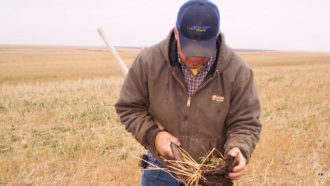Dan Forgey, farm manager at Cronin Farms in South Dakota, has been using no-till management for more than 17 years. Over that time, Forgey has developed a keen understanding of how his farming system works and where new challenges and opportunities exist. Several years ago, Forgey began thinking about how he might include cover crops on the 8500-acre farm to improve soil and the bottom line. But how best to do this in a no-till system? Usually, cover crops are tilled into the soil while they are still green in order to promote soil quality and fertility, but that is not an option in a no-till system. Forgey received a SARE grant to test the feasibility of using cover crops at Cronin Farms. It’s an on-going experiment, but after three years, results are promising. One cover crop mix of turnips, cowpeas and lentils increased corn yields by 18-20 bushels per acre in the SARE farm trials. Other benefits include:
- healthier soil, with increasing benefits over a period of 4 to 5 years
- better soil aggregation and texture through the addition of organic matter and enhanced activity of soil microorganisms
- economic savings as a result of reduced use of purchased fertilizer
Forgey is aware that the cover crops in this system may perform differently in drought years, when a cover crop could deplete soil water needed by the cash crop (wheat, corn, soybeans). He will monitor this closely in coming years. As for managing cover crops without tillage, Forgey's answer is to have his cattle graze them. Enjoy watching this video to learn more.
Download an illustration of the rotations used at Cronin Farms:
Other Dan Forgey Videos
Adding Cover Crops to a No-Till System (14:48)
Growing Cover Crops with a Cash Crop (2:11)
No-Till Farmer: Steward of the Land (5:10)
Want more information? See the related SARE grant:
